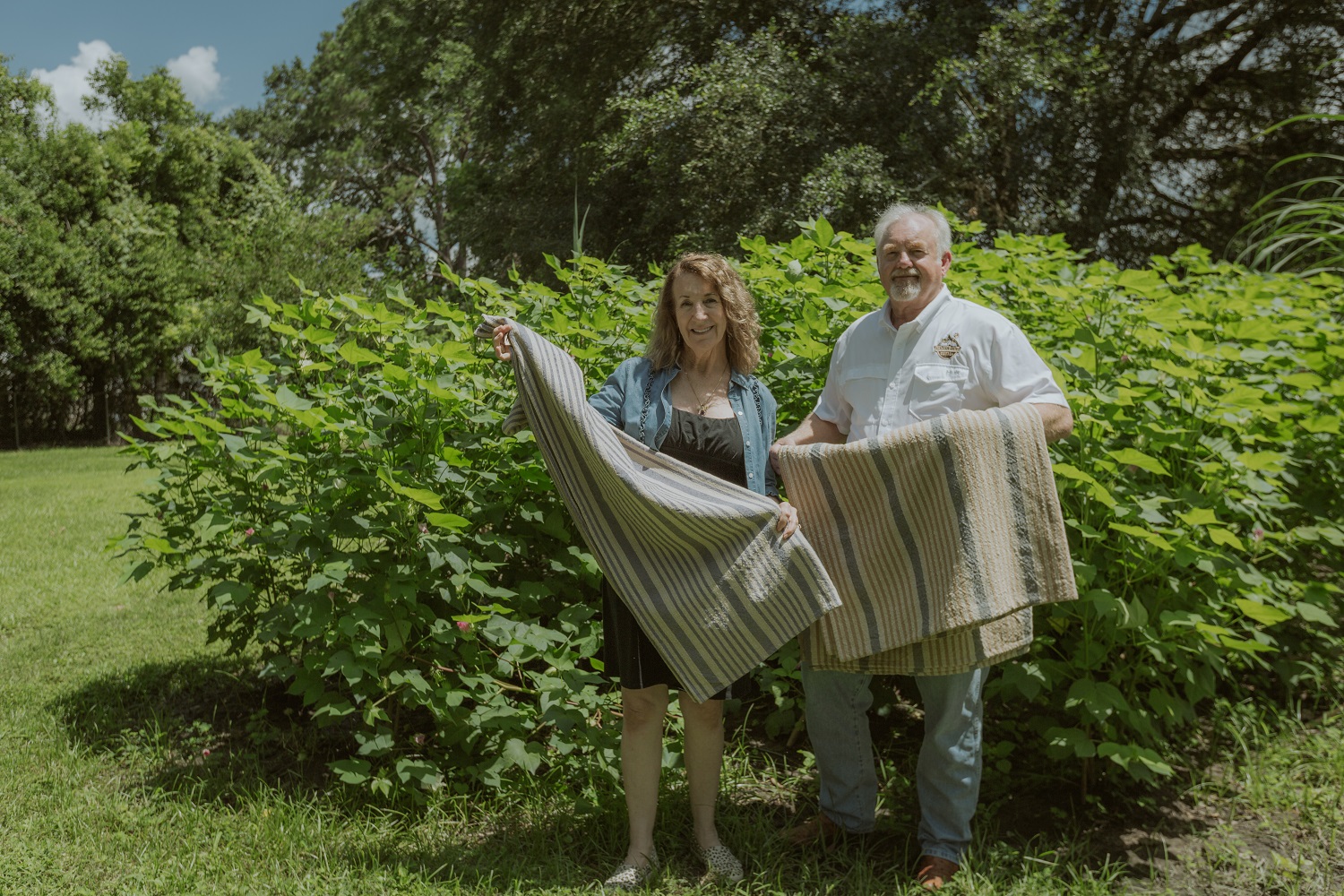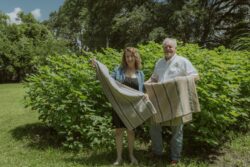Parish Spotlight
Heirloom Variety
A St. Martin Parish farmer keeps Acadian brown cotton growing
Published: February 28, 2022
Last Updated: June 1, 2023

Photo by Lucie Monk Carter
Hale and wife Mary Alice with cotton and Acadian brown cotton blankets.
Hale is the fourth generation of his family to farm. In the 1940s, his grandfather was tending fields a thousand yards from Poverty Point, in northeast Louisiana, as the site and its earthworks came to archeological attention. Learning that the bits of debris he’d been flicking out of his farmland might hold value as artifacts to these frothing archeologists, Hale’s grandfather purchased a grinding wheel and began aging up and selling arrowheads of his own.
“Then one day he saw a green vehicle headed his way,” Hale told me. Thinking the government had his number, the farmer yelled for his sons. Together they heaved the incriminating grinder into Bayou Macon, to join the actually ancient arrowheads he’d found before. The vehicle belonged to yet another archeologist, but the grinder was too heavy to recover. “I visited the Poverty Point World Heritage Site a few years ago, and I pointed out some of the arrowheads on display. I said to the guide, ‘I think my grandfather made some of those.’ He wasn’t amused.”
Hale has followed the family path even further than farming: with his wife Mary Alice, he too recreates the past for present-day value. His small-batch production of Acadian brown cotton textiles bear the same source material, color palette, patterns, and even processes of the stiff relics from your Cajun great-grandmother’s trousseau. Unlike his grandfather, he’s dying to tell people how he did it.
I followed Hale along the path of his backyard garden, which brims with blackberry bushes and fig trees, to the rising rows of brown cotton that have captivated him for the past few years, since local artisan Elaine Bourque gave him two cups of seeds descended through five generations of women in her family.
Bourque, “the premier spinner and weaver of all Acadiana” according to Hale, had kept her own quarter-acre of brown cotton to satisfy her craft. But interest was rising again in a fiber that was local, natural, and woven between mothers and daughters. Hale offered to help regrow the seed. In 2018, his first year, between a backyard patch and a small farm down the road in Sunset, “we produced about forty pounds of seed that we gave to the Cade Wildflower Seed Bank [at University of Louisiana at Lafayette], for preservation and to encourage other farmers.”
Brown cotton was something new to Hale. In North Louisiana, white cotton was his father’s main crop. In the ’60s and ’70s, when Hale was a child, his father managed five thousand acres at Scopena, the family plantation of former Louisiana governor Buddy Roemer, before relocating the family to the seven-thousand-acre Robinson Plantation, south of Shreveport. “It was a whole community. It had a general store, with saddles and Sunday shoes; it had a blacksmith shop, tractors, a tractor shed, hay barns, and corrals.”
Hale’s father was the planter and managed the gin, which ran nonstop during cotton season. Men would rotate shifts operating the gin and sleeping on bales outside. “This was before synthetics, so cotton was the thing,” said Hale. “Cotton was king.”
Working with his father, Hale learned that the cotton couldn’t be planted too close to the pecan trees, where cattle wandered, for any tree disease would bleed into the fields and ruin a crop. He remembers the tidy cycle of the vast property. Geese, untempted by cotton, were kept in the thousands and driven through the fields to nibble away weeds. Machines would pick the long rows and nimble hands would follow the wake, plucking every last fiber. Hale could hoe, harvest, haul, and plant the cotton. He traveled around the property in a mule-drawn wagon to weigh the harvests from sharecroppers. But when he left for college, to study engineering, he didn’t see himself in the fields again. “I got an education so I could get off the farm. I ended up right back here.”
Now in his sixties, white-haired with a neat goatee, Hale bends down one cotton plant and shows me four points along the stem where the cotton is in different stages of growth. The initial bud, or “square,” lengthens into a candle. A flower blooms from the candle, white and then pollinated into pink. The flower dries, furls, and falls off. Left at the base is a boll, which fattens and then cracks. Cotton tufts out, filled with seeds to start again, life after life. But people don’t weave or farm as much as they used to, and over time the brown cotton seed found less purchase in Louisiana soil. “It’s got a short fiber,” said Hale. “It’s harder to spin or weave. White cotton has a longer fiber and you can dye it red, orange, purple, whatever.”
Brown cotton is believed to have traveled up to our state with the Spanish, from the Yucatán Peninsula. When the Acadians settled and could not find wool for their weaving, they opted for brown cotton, or coton jaune (because sometimes it looks more yellow than brown). They’d dyed their wool darker before, but now there was no need. Woven with threads of white cotton and indigo-dyed white cotton, brown cotton formed the basis of many Acadian textiles. These hardy blankets and towels were passed down through the generations; so came the cotton seeds and the skill with which to pull it all together.
The second year, as Hale expanded his crop, he decided to put the excess fiber to its old purpose. With careful photographs, he captured the dimensions and patterns of antique Acadian brown cotton blankets and today replicates the textiles for a small but avid market.
Once Hale removes the seeds from his brown cotton with a small, hand-cranked gin (the seed comes out of the short brown cotton more easily than it does the white), the clean fiber travels to a mill in Charlotte, North Carolina, where Hale used to live and where he grew impressed by a deep textile history in the region. “They’ve got hills,” said Hale, and could muster water power more easily than a flat state like Louisiana. The cotton, now yarn, heads to the Thistle Hill Weavers of Cherry Valley, New York, run by textile historian Rabbit Goody, who, like Hale, eschews machines. She works from Hale’s specifications and sends back throws, towels, and blankets that disappear as soon as Hale calls his waiting list.
He continues to find new patterns inside old armoires across South Louisiana. And the brown cotton in his backyard is rising. The seed is no longer so precious that every cup needs a skilled caretaker. The yield grows and scatters farther: to new cotton farmers mentored by Hale, like musician Louis Michot of the Grammy Award–winning Lost Bayou Ramblers; to exhibitions local and international. At the 2021 Selvedge World Fair, “a celebration of cloth, culture, and creativity,” Hale was highlighted alongside 150 international artisans and the crafts they sustain: mud silk dyeing in China, goat hair weaving in Turkey, tapestries from a village studio in Egypt.
When I leave, Hale gives me an unginned tuft of cotton to take home and better understand. My thumbs find the seeds easily in the brown cloudy fiber. It’s meditative work, and I share it with my daughter.
Lucie Monk Carter is a writer and photographer in Baton Rouge.
